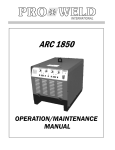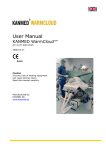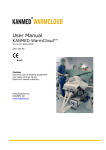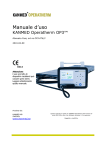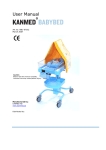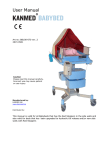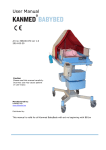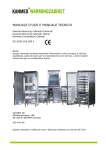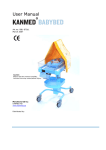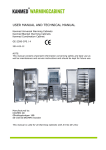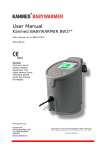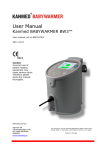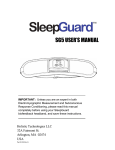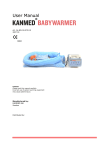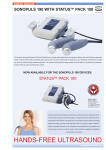Download User Manual - Central Medical Supplies
Transcript
User Manual KANMED Operatherm OP3™ User manual, art no OP3-070/3 2010-02-09 0413 Caution Incorrect use of Heating equipment may cause serious injury. Please read this manual thoroughly. Manufactured by: KANMED AB Gårdsfogdevägen 18B SE-16866 BROMMA SWEDEN www.kanmed.se This manual is valid for KANMED Operatherm OP3 system serial number 0001-08 and above, with Software version 1.0 or higher. Subject to changes. User manual CONTENTS KANMED OPERATHERM OP3 USER GUIDE, QUICK INSTRUCTION…..…………..…………………..3 1 INTENDED USE ....................................................................................................................................... 4 2 EXPLANATION OF SYMBOLS USED .................................................................................................. 4 3 SAFETY INFORMATION ........................................................................................................................ 5 4 USING THE KANMED OPERATHERM OP3 ....................................................................................... 6 5 CLEANING, CHECKS BEFORE USE AND MAINTENANCE ......................................................... 10 6 ACCESSORIES AND SPARE PARTS ............................................................................................... 11 7 TECHNICAL INFORMATION............................................................................................................... 12 8 TECHNICAL DATA................................................................................................................................. 15 9 TROUBLE SHOOTING.......................................................................................................................... 16 10 ANNUAL CHECK OF THE SYSTEM ................................................................................................. 20 11 WARRANTY........................................................................................................................................... 21 12 DISPOSAL............................................................................................................................................. 21 13 EMC COMPATIBILITY STATEMENT............................................................................................... 21 Page 2 of 24 User manual KANMED Operatherm OP3 User Guide Quick instruction Intended Use The KANMED Operatherm OP3 patient warming system is designed to be used pre-, per- and post operatively. It must be used according to this manual. The system is intended to reduce the risk of hypothermia. It is not intended for home use. It should only be operated by qualified medical personnel that have undergone proper product training. Caution! Incorrect use of Heating equipment may cause serious injury. The user manual must be read completely before use. Preparation Position the Heating Pad on the operating table. Cover the Heating Pad with pre-warmed Kanmed Gel Pads. Connect the Heating Pad cable to the front connector on the Control Unit. Connect the power cable to a mains power outlet with protective grounding. The green LED on the Control unit is lit when mains power has been connected. After mains power has been connected the system program will load and it will take approximately 30 sec before the system is ready to be started (when the stand-by screen is displayed). Start/Stop Press the button on the front panel to start. Make sure that the automatic self test is properly performed. When prompted, answer by selecting the “YES” option, confirming that the Heating Pad is covered by Kanmed Gel Pads. If the “No” option is selected, the maximum temperature will be limited to 37°C. The system is set to stand-by by pressing the start/stop button for five seconds. When in stand-by, the mains power may be removed. (An accidentally triggered power alarm can be reset by pressing the on/off button for two seconds). Temperature settings Default temperature setting is 37°C. The average temperature of the Heating Pad can be set between 33°C and 39°C by pressing the [‹] or [›] buttons until desired temperature is displayed. 39°C is the recommended setting, suitable for most situations but should be attuned to the patient’s requirements. Note: When temperature settings above 37°C or below 35°C are selected, the unit will alert the operator by prompting for confirmation. Caution! Always monitor the patient’s actual body temperature with a reliable method. Safety information User Manual Read the whole manual carefully before using the equipment. Reduced Blood Flow Parts of the body that have reduced or no blood flow should never be warmed. Set the system to stand-by well ahead of a blood vessel shut off. Error Codes If an error is detected by the system an acoustic alarm is received and a code is displayed on the Control Unit as “Code XXX”. The meaning of the error code is also indicated by an icon. Full information about the error is found in the user manual. System Malfunction If the Operatherm OP3 self test does not perform correctly, the function supervision has displayed an alarm or error message or the Control Unit has received mechanical damage, it should then be examined by a qualified technician before being used. If you experience that the Operatherm OP3 is not operating properly, immediately turn the system off and consult a qualified technician for advice. Page 3 of 24 User manual User Manual 1 INTENDED USE The KANMED Operatherm OP3 patient warming system is designed to be used pre-, per- and post operatively. It must be used according to this manual. The system is intended to reduce the risk of hypothermia. It is not intended for home use. It may only be operated by qualified medical staff that has undergone proper product training according to the hospital routine. Latest version of the user manual and information about accessories can be found at www.Kanmed.se 2 EXPLANATION OF SYMBOLS USED (Green LED) Mains Power indicator Increase temperature, or change highlighted selection in MENU Start/Stop button Decrease temperature, or change highlighted selection in MENU (Red/Orange LED) Error Indicator MENU Select main MENU, or change highlighted selection in MENU Alarm Silence Select alternative display mode, or change highlighted selection in MENU Please read the instruction manual ENTER, select highlighted item in MENU. Risk of explosion in the presence of inflammable gases. Earth potential equalisation connection point Safety class BF, Defibrillator safe IPX7 Water tight Heating Pad Fulfils MDD93/42/ECC. (Notified Body 0413= Intertek Semko AB, Sweden) Page 4 of 24 User manual 3 SAFETY INFORMATION Warnings • • • • • • • Proper Use. To ensure optimal performance and to prevent incorrect use, the user manual must be read completely before the system is being used. System Malfunction. If the Operatherm OP3 self test does not perform correctly or the function supervision has displayed an alarm or error message or the Control Unit has received mechanical damage, it must be examined by a qualified technician before being used. If you suspect that the Operatherm OP3 is not operating properly, immediately consult a qualified technician for advice. Restricted Blood Circulation. Heat supply to tissue with no, or restricted blood circulation may result in serious tissue damage. Place the Heating Pad where blood circulation is maintained alternatively turn the Operatherm OP3 system off during the period of the restriction. Never use the Operatherm OP3 system without Kanmed GEL Pads! Ensure that there are no wrinkled materials under the patient. Any collection of fluid under the patient, especially disinfecting agents, can cause skin irritation. Electrical Hazard The system must always be connected to a mains power outlet with proper protective grounding. Always remove the mains power cable before cleaning the Control Unit. NOTE: The OP3 may not be interfaced with any other electrical system. If this is done a new “system” is created per definition, and the safety classification of the OP3 may be effected. Body temperature. When using the Operatherm OP3 system, the patient’s actual body temperature (core temperature) should be constantly monitored by a reliable method. Dropped or otherwise possibly damaged. If the Operatherm OP3 Control Unit had fallen to the floor or has been subjected to other possible damage it must be examined by a technician before being used. Caution • • • • • • • • • • • • Gel. The OP3 Heating Pad must always be completely covered by Kanmed Gel Pads. The Gel increases the contact surface and thereby the amount of energy transferred to the patient. It is important to pre-heat Gel Pads in advance because cold Gel Pads will drain energy from the patient. Modifications. Un-authorised personnel are not allowed to open the Control Unit or the Heating Pad Connector. No modifications of the system, of any kind, are allowed since it will void the safety certification of the system and may seriously endanger patient safety. Only original parts may be used. The Heating Pad cable may not be altered in length or repaired in any way. If damaged, the complete Heating Pad must be replaced. Temperature setting. If the OR-table surface is hard, blood pressure is low i.e. bad circulation, old patients, patients with diabetes, etc. 37°C should be the highest temperature setting used. For extraordinarily long operations and for patients sensitive to static pressure (e.g. diabetics), the combination of immobility, skin pressure and warming may prove a bad combination. You may consider not using the Operatherm OP3 system in these cases. Consider Kanmed WarmCloud instead. Temperature reading. Observe that the indicated temperature is a calculated average temperature value and may differ somewhat from local spot temperature readings of the Heating Pad surface. Children and pre-term babies. Patients with low body mass, particularly pre-term babies are easily influenced by the surrounding temperature. They get cold fast and may get fever if over-heated. Be particularly careful when temperature settings above 37°C are being selected. Compatibility. Only KANMED OP3 series Heating Pads can be used with Operatherm OP3 Control Unit. The Operatherm OP3 system is NOT compatible with KANMED OP200 series Heating Pads. EMC. Operatherm OP3 needs to be installed and put into service according to the EMC information provided. (Detailed EMC information can be downloaded from www.Kanmed.se) DIATHERMY equipment and Defibrillators. Under normal circumstances the Operatherm OP3 is not disturbed by this type of equipment. However, if the diathermy or defibrillation is set at very high output levels, the Operatherm OP3 might go into alarm state. In such a case, restart the system and observe that the self test is being performed correctly. Note that the Control Unit housing is electrically connected to earth. ECG disturbance. Under unfavourable conditions there is a risk that interference may occur on ECG traces. This may occur if the ECG electrodes are not being applied strictly to the manufactures instructions or if the Operatherm OP3 Heating Pad is positioned upside down (text side facing down). MRI cameras. The system is not designed for use with MRI cameras. Heating Pad storage. The Heating Pad should be stored using the Pad Hanger for wall mount that is included in all control unit deliveries or rolled to a diameter not less than 150mm. Do not bend or fold the Heating Pad in a way that sharp crease arises. Cleaning. Users should not use cleaning or decontamination methods different from those recommended by Kanmed without first checking with Kanmed that the proposed methods will not damage the equipment. Page 5 of 24 User manual 4 USING THE KANMED OPERATHERM OP3 THE CONTROL UNIT The Control Unit contains a microprocessor based heating control system that regulates the temperature of each of the elements (heating zones) in the Heating Pad. The temperature is continuously monitored and the calculated average temperature of the Heating Pad is displayed. Automatic Self Test Every time the Operatherm is switched on it will perform an automatic self-test of all functions including the internal safety-circuit. If an error is detected, the Operatherm OP3 will not start the heating, the acoustic alarm will sound and the type of error is being indicated by the display. Warning! Never use the system if the self test does not perform correctly! Front Panel Layout 1. 2. 3. 4. 5. 6. 7. Display Navigation Pad Heating Pad connector Alarm indication LED Power indication LED Alarm reset button ON/OFF button Rear Panel Layout The rear-panel contains information about manufacturer, part number, serial number, voltage, etc. Mains power cord, and optional earth potential equalisation grounding is also connected here. Page 6 of 24 User manual HEATING PAD The 104 cm long standard Heating Pad OP3-104 (and the 150 cm Pad OP3-150) consists of eight individual heating zones (elements), and the Heating Pads OP3-063 and OP3-050 of four zones. Each zone is temperature regulated separately. Thanks to this unique feature the heat is supplied to the part of the Pad where it is most needed. The individual elements are insulated from each other and embedded in a Mylar foil. They are hermetically sealed into the soft hospital grade plastic foil. The Heating Pad is watertight and easy to clean. Element voltage is only about 30 Volts DC. The Pad is connected to the front of the Control Unit. The Pad Connector contains a flash memory for calibration parameters of the elements, logged information of the previous sessions and an independent safety circuit. PREPARATION The Heating Pad Place the Heating Pad on the OR-table with the printed side up and make sure it is not folded. Cover the Heating Pad completely with pre-heated Kanmed Gel Pads and a bed-sheet. Gel Pad GE-455015 (50 x 45 x 1,3 cm) Fits the OP3-104 and OP3-150 Heating Pads. Use two Kanmed Gel Pads on OP3-104 and three on OP3-150. Gel Pad Gel Pad GE-436315 GE-305015 (63 x 43 x 1,3 cm) (50 x 30 x 1,5 cm) Fits the Heating Pad OP3-063 Fits Heating Pad OP3-050 Connect the Heating Pad to the Control Unit and make sure that the connector engages fully. Mains Connection Connect the power cable to a mains power outlet with protective grounding. The green LED on the Control Unit is flashing when mains power has been connected. After mains power has been connected the computer will automatically boot (load the software) and it will take approximately 30 sec before the system is ready to be started (when the stand-by screen is displayed). Location of the Control Unit Locate the Control Unit where its display can be easily observed. It can be hung on its handle. Note that the handle and the enclosure are electrically connected to protective earth. START Switch the unit on by pressing the start/stop button on the front panel. Observe that a correct self test is executed. Confirm that Kanmed Gel Pads have been properly applied by selecting “√” (press [›] button and “Enter”). The heating will now start automatically at 37°C. During the first 10 minutes after start, the Operatherm will perform a “power boost” cycle permitting maximum output power to be fed to the Heating Pad. After 10 minutes, the maximum output power will be reduced. Note 1: If the Operatherm OP3 does not behave as described above it shall not be used and must be examined by a qualified technician. Note 2: During the first 10 minutes after start, the Operatherm will perform a “power boost” cycle permitting maximum output power (approximately 180 W) to be fed to the Heating Pad. After 10 minutes, maximum output power will be limited. Different types of Pads have different power limits. STOP Set the system to stand-by by keeping the start/stop button on the front panel pressed for more than 5 sec. In stand-by mode the mains power may be removed for a complete power down. Note: The Operatherm OP3 is designed to be left running continuously, so it can keep the Gel Pads heated and be ready for use at any time. Page 7 of 24 User manual TEMPERATURE SELECTION The default setting is 37°C. The average temperature of the Heating Pad can be set between 33°C and 39°C by pressing the [‹] or [›] buttons until the desired temperature is displayed. 39°C is the normally recommended temperature setting suitable for most situations, but should be attuned to the patient’s requirements. Note: When temperature settings above 37°C or below 35°C are being selected, the unit will alert the operator by prompting for confirmation. NAVIGATION During normal operation, two different display screens can be selected. The OP3 will start with the default display screen giving information of the set- and actual temperature, actual power emission and elapsed time since power on. By pressing the “down arrow” the “Temp and Power” screen is displayed. This screen is useful for monitoring the distribution of power and temperature to the different temperature zones of the Heating Pad, and for information of how much energy has been emitted during the current session. The set temperature can not be changed when this screen is displayed. If “up arrow” is pressed, the system returns to the default display screen. GELPADS Always cover the Heating Pad completely with Kanmed Gel Pads. Always use Kanmed Gel Pads to get an even heat distribution, a greater contact surface with the body of the patient and reduce the risk of pressure sores. Always pre heat the Gel Pads. Cold Gel Pads will actually drain energy from the patient during the first 20 - 40 minutes. The Gel Pads should preferably be pre-heated to 42°C (KANMED Warming Cabinets are designed for this purpose). A thin bed-sheet can be placed over the Gel Pads (under the patient). The most efficient pre-heating method is the Kanmed Warming Cabinet. An alternative, is to roll the Gel Pads together with the Heating Pad and leave the system running on maximum temperature setting for more than 2 hours. Page 8 of 24 User manual EXPLANATION OF THE DISPLAY SCREENS The system has a screen saver function, causing the display to dim the back light 30 minutes after pressing any button. This function is common for all display screens. In order to “wake” the system up from screen saving mode, just press any button. Start Up Shown when the mains power has been connected. Start Up screen This screen is displayed shortly after the unit has been connected to mains power, and is displayed during the time the computer is booting (about 20 sec.), followed by a blank screen during 10 sec. After the blank screen the system will go to standby. Stand by screen This screen is displayed when system is in standby, and is ready to be switched on (by pressing the on/off button), or to access the technical menu by pressing “menu”. To shut down the system completely, the mains power cord must be removed. This is only doable when the system is in stand-by, (otherwise the power loss alarm will be triggered). Normal Operation Functions accessed after pressing the on/off button when in standby mode. Self test screen The self test will start automatically when the on/off button is pressed. Information of diagnostic tests being performed is displayed (checked parts turning green if found OK). If an error is detected, an error message will be displayed (see chapter trouble shooting). The alarm LED will flash orange/red rapidly during the Heating Pad test. A short acoustic alarm signal will sound when the self test is completed. GEL confirmation screen Prompting the operator to confirm that the Kanmed Gel Pads are properly applied. Positive response enables the use of temperature settings above 37°C. NOTE: When positively confirmed by moving the highlighted selection to the green “√” (using the [‹] or [›] buttons) and pressing “Enter”, the Default screen will be viewed and the system will start operating at the default temperature setting of 37°C. Higher temperature settings are permitted. If “X” is selected, the system will start operating at the default temperature setting of 37°C. Temperature setting will now be limited to max 37°C. Page 9 of 24 User manual Default display Information about: 1. Elapsed time since start-up 2. Heating Pad power 3. Heating Pad temperature 4. Set (desired) Heating Pad temperature 5. Gel indicator (icon present if positively confirmed) 6. Status bar Temperature settings When temperature settings below 35°C or above 37°C are being selected, the unit will alert the operator by prompting for confirmation (operator to press “Enter”) TIPS: An extra press on the [‹] button also acts as “enter” when low temp setting is selected and [›] button when high temp setting is selected. Power and energy display By pressing the “down arrow”, the system displays information about: 1. P = Current Heating Pad power. 2. E = Energy output from start-up 3. Heating Pad temperature (average value). 4. Set temperature 5. Individual temp and power information of each of the 8 Heating elements in the Pad. A new press on the “down arrow” or the “up arrow” returns the system to the default operating screen. NOTE: The set temperature can not be changed when this screen is displayed. Pls. return the system to the default display by pressing the “down arrow” if set temperature is to be changed. 5 CLEANING, CHECKS BEFORE USE AND MAINTENANCE Cleaning / Disinfecting Always unplug mains power cord before any maintenance procedure. Wipe off the Control Unit with a moist cloth and if necessary use normal hospital cleaning agent. Clean the watertight Heating Pad with soap or your usual cleaning agent. Disinfect the Pad with alcohol or any other commonly used disinfectant. NOTE: Do not autoclave the Pad. Do not submerge the connector in any liquid. Checks before use Check that all parts are clean and in god condition. Check that the unit performs a correct self test at start. If error codes appear and can not be eliminated with the suggestions given in the trouble shooting section of this document, then it should be notified to Technical staff. Note: If any part of the system has received mechanical damage, it should always be checked and correct system function verified by technical staff. Maintenance Kanmed Operatherm OP3 does not require any special maintenance apart from what is described in the technical section of this manual. Storage The Heating Pad shall be stored hanging with the Pad Hanger or lying flat. Avoid folding. Page 10 of 24 User manual 6 ACCESSORIES Article no. Product OP3-022 Control Unit OP3-115 OP3-100 Control Unit Control Unit OP3-104 104 cm Heating Pad OP3-150 150 cm Heating Pad OP3-063 Short Heating Pad OP3-050 Small Heating Pad GE-455015 Gel Pad GE-305015 Gel Pad GE-436315 Gel Pad OP3-005 OP3-070 OP3-079 OP3-099 Pad Hanger User manual * Service Manual Calibration Adapter Comment Includes Pad Hanger, mains cord and instruction manual. Factory set to 220-240V AC, 50/60 Hz As above, but set to 100-120 AC, 50/60 Hz As above, but set to 100V AC, 50/60 Hz 1040 x 450 mm. X-Ray translucent. Standard Heating Pad. Fits most patients. Requires two standard Kanmed Gel Pads. 1500 x 450 mm. X-Ray translucent. Requires three standard Kanmed Gel Pads. 630 x 430 mm. X-Ray translucent. Must always be used with the Gel Pad no GE-436315. For small children during surgery, post operative warming, under radiant heaters, on resuscitation tables. 500 x 300 mm. X-Ray translucent. Must always be used with the Gel Pad no GE-305015. For small children during surgery, post operative warming, under radiant heaters, on resuscitation tables and in baby cribs. 500 x 450 x 13 mm. Standard Gel Pad. 300 x 500 x 15 mm. Fits perfectly over Heating Pad OP3050. Equipped with a pocket for the Heating Pad 630 x 430 x 13 mm. Fits perfectly over Heating Pad OP3063. Wall mounted hanger for the Heating Pads. English. English. For checking the Control Unit calibration. SPARE PARTS Article no. Product Comment 700-0751 700-0766 Rubber Frame Rear label PAD Connector casing CU Front label CPU unit incl front Main board Power board Power transformer Power transformer Mains power intake Connector Saver CU Rear panel Cable kit CU Handle CU Bottom plate CU Cabinet Elastosil A07, 90ml NOTE: Two pcs per unit is required. 700-0748 700-0765 300-001 300-002 300-003 300-004 300-005 300-006 300-007 300-008 300-011 300-012 300-013 300-014 700-0255 Plastic pad-connector housing (top/bottom) incl. screws. (OP303-1 Display and Computer board) (Op303-2) (OP303-3) (the large power transformer, 2 x 28,6 V 300 VA) (electronics power supply transformer, 10,3 V 9 VA) With RF filter 37 pin F/F excl. label Internal control unit cable kit (naked cabinet) Silicon based adhesive for fixing the rubber frames. * Latest version of the manual can be downloaded from www.Kanmed.se For the latest information about accessories, please visit www.Kanmed.se or contact your local dealer. Page 11 of 24 User manual 7 TECHNICAL INFORMATION The Control Unit contains a microprocessor based heating control system that regulates the temperature of each of the 8 elements (heating zones) of the Heating Pad. The temperature is continuously monitored and the calculated average temperature of the Heating Pad is displayed. The safety system in the Control Unit is continuously monitoring the main power, internal voltages, running parameters, the Pad condition and the behaviour of each element. Two autonomous safety circuits, totally independent of the microprocessor based operating system, can at any time stop the warming, should conditions occur that can cause over temperature. If a fault is detected, the Control Unit will alarm visually and acoustically and switch off the heating. The type of error is indicated on the alarm display. A description of the error codes are found under the chapter “Trouble Shooting”. “MENU” This function is accessed if the “Menu” (up arrow) button is pressed when the unit is in stand by mode. This menu or these functions are not available during normal operation of the system. They are exclusively designed for system set-up or technical function control. Main Menu screen Top menu. Navigate by pressing the “up arrow” or “down arrow” to highlight the desired action and press “enter”. EXIT returns the system to stand-by mode. NOTE: “up arrow” (menu) exits the function and returns the system to stand-by mode. System Settings Navigate by pressing the “up arrow” or “down arrow” to highlight the desired action and press “enter”. EXIT returns the system to the Main Menu. NOTE: “up arrow” (menu) exits the function and returns the system to the Main Menu. Set Time and date Date will be set on the format YYYY-MM-DD and time on the 24 hour format HH-MM-SS. Navigate by pressing the [‹] or [›] buttons to highlight the desired digit to be changed and press “down arrow” to alter the value of the digit. “Enter” saves the new setting and returns the system to the System Settings menu. “Menu” (up arrow) ignores any change and returns the system to the System Settings menu. NOTE: “up arrow” (menu) exits the function and returns the system to the System Settings menu without changing the time or date. Page 12 of 24 User manual Set Identifier A name of up to 10 characters can be given the unit (and will be displayed in the bottom left corner of the screen). Navigate by pressing the [‹] or [›] buttons to highlight the desired position to be changed and press “down arrow” to alter the character (A to Z _0 to 9) “Enter” saves the new setting and returns the system to the System Settings menu. “Menu” (up arrow) ignores any change and returns the system to the System Settings menu. NOTE: “up arrow” (menu) exits the function and returns the system to the System Settings Menu without changing the set name. Write logs to USB (technical function) System log files can be written to a USB memory stick for offline analyzes. Connect a USB memory stick to the internal USB connector, highlight this function and press “Enter”. Wait until the text “Writing Data” has disappeared before exiting the function. The Control Unit will now have written a copy of its internal log files to the connected USB memory. NOTE: The Control Unit must be opened to access the USB connector. This is an operation that only shall be performed by trained technical staff. Technical Data Several system functions can be monitored and controlled, e.g. SW version data, calibration data etc. These functions are exclusively designed for technical staff and maintenance personnel. NOTE: This is functions that only should be used by trained technical staff. Control Unit Summary Information of SW version, Calibration information, Running hours and No of system starts (operating sessions) “Menu” (up arrow) returns the system to the Technical data menu. NOTE: This is functions that only should be used by trained technical staff. Page 13 of 24 User manual Control Unit Calibration Data Factory set Calibration values for each of the 8 channels. “Menu” (up arrow) returns the system to the Technical data menu. NOTE: This is functions that only should be used by trained technical staff. Heating Pad Data Summary Information about the connected Pad. SW version, Calibration information, Running hours and No of starts (operating sessions). “Menu” (up arrow) returns the system to the Technical data menu. NOTE: This is functions that only should be used by trained technical staff. Heating Pad Calibration Data Information about the connected Pad. Factory set Calibration values for each of the 8 elements. “Menu” (up arrow) returns the system to the Technical data menu. NOTE: This is functions that only should be used by trained technical staff. System Measurements This function measures each of the eight channels separately for deep analyze of the system measurement accuracy and the condition of each of the elements in the connected HeatingPad. Press the [‹] or [›] buttons to change the channel to study. “Menu” (up arrow) returns the system to the Technical data menu. NOTE: This is functions that only should be used by trained technical staff. Log Data Information about the latest session. Press the [‹] or [›] buttons to change the log to study. “Menu” (up arrow) returns the system to the Main menu. Page 14 of 24 User manual 8 TECHNICAL DATA Control Unit Voltage Frequency Power consumption Temperature range Temperature accuracy Resolution Over-temperature alarm level Dimensions Weight Mode of operation Art. no: OP3-022 Internally selectable; 100 V AC, 110-120 V AC, 220-240 V AC 50/60 Hz 285 VA (max) 33°C to 39°C in steps of 1°C Better than ±1°C 1°C (Display resolution 0.1°C) 41.0°C ± 0.5°C L 255 mm, W 150 mm, H 120 mm. 6 kg Continuous Common for all Heating Pads Voltage Length of cable Water protection Surface, electrical properties 30 V DC 2900 mm Watertight, except for connector Not electrical conductive Heating Pad Standard (104cm) No. of elements: Max Power Dimension Weight Art. no: OP3-104 8 200 W (8 x 25 W) L 1040 mm, W 450mm, H 3 mm 2 kg Heating Pad Long (150cm) No. of elements: Power Dimension Weight Art. no: OP3-150 8 200 Watt (8 x 25W) L 1500 mm, W 450 mm, H 3 mm 2,6kg Heating Pad Short (63cm) No. of elements: Power Dimension Weight Art. no: OP3-063 4 100 W (4 x 25W) L 630 mm, W 430 mm, H 3 mm 1,6 kg Heating Pad small (50cm) No. of elements: Power Dimension Weight Art. no: OP3-050 4 100 W (4 x 25W) L 500 mm, W 300 mm, H 3 mm 1,1 kg Heating up time Elements inside the Heating Pad Heating Pad surface about 8-10 minutes from 20°C to 37°C about 25 minutes from 20°C when tested under conditions of “ADEQUATE HEAT DISCHARGE” in (IEC601-2-35) Environment Operating temperature Shipping and storage Humidity +15°C to + 40°C - 20°C to + 60°C 10% to 85% RH non condensing Safety Standards Protection type Protection class MDD classification EN60601-1, EN60601-1-2, IEC60601-2-35 BF, Defibrillator safe Class I Class IIb Page 15 of 24 User manual 9 TROUBLE SHOOTING Function Supervision and Alarms Apart from a complete self test when the system is turned on, (where all vital parts and safety functions are being tested), the Operatherm OP3 supervises the function of the system during normal operation and will render alarm or alert for any of the following fault conditions: • Incorrect temperature (e.g. high or low temperature alarm) • Heating Pad error (defective Heating Pad or to much energy being fed to the Pad) • Control Unit error (internal error detected). • Power Failure. (In case of a mains power failure, the Operatherm alarms by flashing the power indication LED and sounding the beeper intermittently. The power failure alarm is kept active for at least 10 min. The power alarm can be silenced by the operator by pressing the on/off button for about 2 seconds). For added safety against over-temperature due to electrical short circuits, multi fault conditions or similar unforeseen general errors in the Control Unit, each of the OP3 series Heating Pads has its own, completely independent safety circuit located in the Heating Pad connector. This circuit monitors the feeding voltage to each of the eight elements in the Heating Pad at all times and if an error is detected, it will cause the Control Unit to cut the power feed to the Heating Pad (trip the safety relay). Two different conditions will cause the safety circuit to activate: 1. If this circuit detects an unregulated voltage being fed to any of the elements (e.g. a major error in the Control Unit causing short circuit output). 2. If the Control Unit is feeding more energy than 25000 Ws over a period of 30 minutes to any of the elements, e.g. error in the temperature regulation – or an abnormally high thermal load. In case the Operatherm OP3 indicates an alarm, note the error code indicated (see explanation of the codes further down in this section). If there is a logical explanation, try to eliminate the condition that is causing the alarm. Restart the unit and observe a correctly executed self test. In case the alarm comes back without apparent reason, the unit must be fully examined by a qualified technician. Note: If the mains power is removed before the Control Unit is set to standby, or the on/off button is unintentionally pressed when the main power is not connected, the alarm will start! This “false” alarm is reset by simply pressing the on/off button for about 2 seconds. Alerts Informative system messages only, the system will continue operation. Alert display and Error Code Description / Operator actions Slow cooling. The Heating Pad has a higher temperature than the Control Units set temperature. The status bar displays a thermometer-icon as long as this condition persists. Action: No action normally required. This alert might occur when the set temperature is reduced from a higher setting. Slow heating. One or more of the Pad elements has not reached 2°C less than the set value after 10 minutes. Action: No action normally required. This alert might occur when the unit starts from a cold condition. If the system is re-started, a new 10 minutes power boost period will occur and help the system to faster reach the set temperature. Defective elements. A Heating Pad with one or two defective elements has been connected to the Control Unit. Action: Reset the alert. The Pad may be used but should be replaced by a correct Pad at earliest opportunity. Page 16 of 24 User manual Medium severity alarms An error in this category turns the heating off but permits resumed operation after the alarm has been reset. Alarm display and Error Code Description / Operator actions Pad element resistance outside of nominal limits. The Pad resistance deviates more than 20% from the anticipated value. This may occur when a Heating Pad is beginning to go defective. Action: Reset the alarm. If the alarm re-occurs, the Heating Pad should be analyzed and/or replaced Alarm display and Error Code Action: If there is a logical explanation (a cold start when the Pad is chilled), just reset the alarm and the system will operate as usual. If the Heating Pad actually is warm, or the alarm re-occurs, the Heating Pad or the Control Unit should be analyzed and/or replaced. Slow cooling. The average temperature of the Pad has had a calculated temperature higher than the set value, during 5 minutes. Hot-spot warning. One or several of the Pad elements has had a calculated temperature higher than the set value, during 10 minutes. Action: If there is a logical explanation (something has accumulated the heat), just reset the alarm and the system will operate as usual. If there is no apparent unusual operating condition, or the alarm re-occurs, the Heating Pad or the Control Unit should be analyzed and/or replaced. Action: If there is a logical explanation (a lowered temperature setting with a heavy body on the Pad that has accumulated excessive heat), just reset the alarm and the system will operate as usual. If there is no apparent unusual operating condition, or the alarm reoccurs, the Heating Pad or the Control Unit should be analyzed and/or replaced. Abnormal temperature variation detected. A change in the Pad temperature faster than 5°C in 3 sec has been detected. The Control Unit’s log-file is very large (time for service of the unit). Action: The alarm can be reset and the system will operate as usual. Before the unit is used next time, the Control Unit should be serviced by an authorized technician. Description / Operator actions Low initial Pad temperature. The Control Unit has calculated the Heating Pad temperature to a value lower than 15°C. Action: The alarm can be reset and the system will operate as usual. If there is no apparent unusual operating condition, or the alarm re-occurs, the Heating Pad or the Control Unit should be analyzed and/or replaced. Page 17 of 24 User manual High severity alarms An error in this category turns the Heating off. After the alarm has been reset the system goes to standby. The unit needs to be re-started and an automatic self test carried out. Alarm display and Error Code Description / Operator actions Error in the measuring circuitry, no acceptable data received during 20 sec. Probably caused by defective components. Action: The Control Unit should be analyzed by an authorised technician. Alarm display and Error Code Action: The Control Unit should be analyzed by an authorised technician. The Control Unit has corrupted software. Probably caused by defective components, faulty memory circuits or software error. Action: The Control Unit should be analyzed by an authorised technician. The Heating Pad has corrupted software. Probably caused by defective components, faulty memory circuits or software error Action: The Heating Pad should be analyzed by an authorised technician. The Heating Pad is not correctly calibrated. The Heating Pad connector is not properly fitted, or damaged. Action: Try to re-fit the Pad connector and restart the unit. If the error persists, the Pad and the Control Unit’s connector saver should be analyzed by an authorised technician. Description / Operator actions Internal communication error. Probably caused by defective components, faulty memory circuits or software error. Action: The Heating Pad should be returned to KANMED for analysis. The Pad has too many defective elements to be used (three of eight, or two of four) to be used. The Heating Pad is not correctly validated after calibration. Action: The Heating Pad must be replaced. Action: The Heating Pad should be returned to KANMED for analysis. Average temperature has exceeded 41°C for more than 30 sec. Page 18 of 24 The safety circuit has been activated. User manual Action: Reset the alarm and restart the unit. Observe the temperature behaviour on the display. If there is no apparent unusual operating condition, or the alarm re-occurs, the Heating Pad or the Control Unit should be analyzed and/or replaced. Action: Reset the alarm. If there is a logical explanation e.g. a massive cold object is draining more than normally anticipated amount of heat from the Pad, disconnect the Heating Pad connector and re-connect it (in order to reset the internal safety relay). Restart the unit and observe the temperature behaviour on the display. If there is no apparent unusual operating condition, or the alarm re-occurs, the Heating Pad or the Control Unit should be analyzed and/or replaced. Serious hot-spot warning 1. One or several of the Heating Pad elements has had a calculated temperature higher than 41°C for 3 minutes. Action: Reset the alarm and restart the unit. Check the actual temperature under the patient. If there is no apparent unusual operating condition (e.g. the Pad being heated by another external device), the Heating Pad and the Control Unit should be analyzed and/or replaced. Serious hot-spot warning 2. One or several of the Heating Pad elements has reached a calculated temperature higher than 43°C. Action: Reset the alarm and restart the unit. Check the actual temperature under the patient. If there is no apparent unusual operating condition (e.g. the Pad being heated by another external device), the Heating Pad and the Control Unit should be analyzed and/or replaced. Power loss has occurred during normal operation. The A/D converter (used to calculate Pad temperature) reports inconsistency. Action: Reset the alarm and restart the unit. If there is no apparent unusual operating condition, or the alarm re-occurs, the Control Unit should be analyzed and/or replaced. Action: The power alarm can be silenced by the operator by pressing the on/off button for about 2 seconds. Restart the unit after the power has been restored. Note: If the mains power is removed before the Control Unit is set to standby, or the on/off button is unintentionally pressed when the main power is not connected, the alarm will start! This “false” alarm is reset by simply pressing the on/off button for about 2 seconds. Error when Control Unit is writing to the internal log file. Error when Control Unit is writing to the Pad log file. Action: Reset the alarm and restart the unit. If the alarm re-occurs, the Heating Pad or the Control Unit should be analyzed and/or replaced. Action: Reset the alarm and restart the unit. If the alarm re-occurs, the Control unit should be analyzed and/or replaced. The system measurements temporarily unreliable. May be caused by powerful interference from other equipment or similar. No memory space left when Control Unit is writing to its internal log file. Action: Reset the alarm. The Control Unit needs to be serviced by an authorised technician. Action: Reset the alarm and restart the unit. If the alarm re-occurs, the Control Unit should be analyzed and/or replaced. Page 19 of 24 User manual Earth current flow is detected in the ground plane of the Heating Pad. This will occur if the Heating Pad has been severely mechanically damaged or penetrated by an sharp object. Action: Reset the alarm. The Heating Pad and the Control Unit needs to be serviced by an authorised technician. 10 ANNUAL CHECK OF THE SYSTEM Maintenance carried out by technical staff. • Exchange of connector saver. Annual check of the system The system must be checked annually by a qualified technician. The following shall be tested: • • • Visual control of the Control Unit and Heating Pad as well as cables. Complete electrical safety test (as per hospital regulation). Check of the safety functions, as per the list below. For further service activities we ask you to refer to the service manual. a) Check of system calibration. Connect the optional calibration adapter to the Control Unit (to the Pad connector). The system will automatically perform the calibration control by measuring the reference resistance in the calibration adapter and display the result on the screen. Leave the system running for about 5 minutes. If the Control Unit measure the correct resistance within tolerance, the measured value turns green, if the measurement is outside of acceptable tolerance, the value turns red. b) Check of Mains Failure alarm. Remove the power cord from the Control Unit during normal operation. The alarm should trigger momentarily. Silence the alarm by pressing the on/off button for about 2 seconds. c) Check of Heating Pad safety circuit. Expose the Heating Pad to an excessive thermal load, by rolling the heating and inserting it in a bucket with room temperature water. Run the system at 39°C for approximately 10 minutes. (also note that after 10 minutes the heating output per heating element will drop to about 10 watt)Restart the system and let it run another 10 minutes. Repeat this a third time and observe that the alarm triggers and Error code 60 is received. Total test time about 25 minutes. To reset Error code 60 you have to disconnect the Heating Pad. d) Check of over temperature alarm. Run the system at 39°C. Warm any point of the Heating Pad with a warm air blower (e.g. a hair dryer) and observe the individual temperature readings on the Power and Energy display. When the element corresponding to the spot being heated reaches 43°C the alarm should trigger and Error code 62 being received. Technical documentation The service manual provides information to assist the user's appropriately qualified technical staff to exchange parts of the equipment that are designated by the manufacturer as exchangeable. NOTE: Only KANMED factory is authorised to perform repairs on the printed circuit boards. Expected lifetimes Control unit OP3. Kanmed warrants a safe lifetime for Control unit OP3 of 10 years from first day of use. This is under the condition that the unit has been serviced according to the user and or service manual and that the unit has not been modified or changed in any way or for any reason. Heating Pad. Heating Pads are consumable products and the expected lifetime is one to two years depending how they are handled and how often they are used. Page 20 of 24 User manual 11 WARRANTY KANMED AB warrants the Operatherm OP3 Control Unit and Heating Pads for a period of 12 month from the purchase date. In case of a warranty matter KANMED may on its own judgement decide to: • • • Repair the unit with new or exchanged parts Change the equipment Take the unit back against a refund This warranty is not valid if: • The product has been modified, adjusted or repaired without the written consent of KANMED. • The product has been modified, adjusted or repaired without following the written KANMED guidelines. • The unit has been used for other purposes than the intended use, misused, dropped or in any other way been abused. Warranty claims must be confirmed in writing. KANMED is not responsible in any way for any damages arising from deviation from the intended use, neglect of safety instructions, neglect of alarms, neglect of annual service etc. 12 DISPOSAL When the Operatherm OP3 have reached end of life, it should be returned to the distributor for recycling in accordance with the EU 2002/96/EC (WEEE) directive if applicable. 13 EMC COMPATIBILITY STATEMENT EMC Guidelines for the Operatherm OP3 system • • Portable and mobile RF communications equipment can affect MEDICAL ELECTRICAL EQUIPMENT. The KANMED Operatherm OP3 system should not be used adjacent to, or stacked with other equipment. If adjacent or stacked use is necessary, the KANMED Operatherm OP3 system should be observed to verify normal operation in the configuration in which it is used. Guidance and manufacturer’s declaration - electromagnetic emissions The KANMED Operatherm OP3 system is intended for use in the electromagnetic environment specified below. The customer or the user of the KANMED Operatherm OP3 should assure that it is used in such an environment. Emission test RF emissions CISPR 11 Compliance Electromagnetic environment - guidance Group 1 KANMED Operatherm OP3 system uses RF energy only for its internal function. Therefore, its RF emissions are very low and are not likely to cause any interference in nearby electronic equipment. RF emissions CISPR 11 Class B Harmonic emissions IEC 61000-3-2 Class B Voltage fluctuations/ flicker emissions IEC 61000-3-3 Complies The KANMED Operatherm OP3 system is suitable for use in all establishments, including domestic establishments and those directly connected to the public low-voltage power supply network that supplies buildings used for domestic purposes. Page 21 of 24 User manual Recommended separation distances between portable and mobile RF communications equipment and the KANMED Operatherm OP3 system. The KANMED Operatherm OP3 system is intended for use in the electromagnetic environment in which radiated RF disturbances are controlled. The customer or the user of the KANMED Operatherm OP3 system can help prevent electromagnetic interference by maintaining a minimum distance between portable and mobile RF communications equipment (transmitters) and the KANMED Operatherm OP3 system as recommended below, according to the maximum output power of the communications equipment. Rated maximum output power of transmitter W Separation distance according to frequency of transmitter m 150 kHz to 80 MHz d = 1,17 √ P 80 MHz to 800 MHz d = 1,17 √ P 800 MHz to 2,5 GHz d = 2,33 √ P 0,01 0,2 m 0,2 m 0,3 m 0,1 0,4 m 0,4 m 1,6 m 1 1,2 m 1,2 m 2,3 m 10 3,7 m 3,7 m 7,4 m 100 11,7 m 11,7 m 23,3 m For transmitters rated at a maximum output power not listed above, the recommended separation distance d in metres (m) can be established using the equation applicable to the frequency of the transmitter, where P is the maximum output power rating in watts (W) according to the transmitter manufacturer. Note 1: At 80 MHz and 800 MHz, the separation distance for the higher frequency range applies. Note 2: These guidelines may not apply in all situations. Electromagnetic propagation is affected by absorption and reflection from structures, objects and people. Guidance and manufacturer’s declaration - electromagnetic immunity The KANMED Operatherm OP3 system is intended for use in the electromagnetic environment specified below. The customer or the user of the KANMED Operatherm OP3 system assures that it is used in such an environment. Electromagnetic immunity test IEC 60601 test level Compliance level environment - guidance Electrostatic discharge (ESD) Floors should be wood, IEC 61000-4-2 concrete or ceramic tile. If ±6 kV contact ±6 kV contact floors are covered with ±8 kV air ±8 kV air synthetic material, the relative humidity should be at least 30% Electrical fast transient/burst ±2 kV for power supply lines ±2 kV for power supply lines Mains power quality should IEC 61000-4-4 ±1 kV for input/output lines ±1 kV for input/output lines be that of a typical commercial or hospital Surge ±1 kV differential mode ±1 kV differential mode environment IEC 61000-4-5 ±2 kV common mode ±2 kV common mode Voltage dips, short interruptions <5% UT <5% UT (>95% dip in UT ) (>95% dip in UT ) and voltage variations on the for 0,5 cycle for 0,5 cycle power supply input lines Mains power quality should IEC 61000-4-11 be that of a typical 40% UT 40% UT commercial or hospital (60% dip in UT ) (60% dip in UT ) environment. for 5 cycles for 5 cycles If continued operation during power mains interruptions, it 70% UT 70% UT is recommended that the (30% dip in UT ) (30% dip in UT ) KANMED Operatherm OP3 for 25 cycles for 25 cycles system be powered from an uninterruptible power supply <5% UT <5% UT unit (UPS) (>95% dip in UT ) (>95% dip in UT ) for 5 sec for 5 sec Power frequency (50 Hz) magnetic field IEC 61000-4-8 Note: 3 A/m 3 A/m UT is the AC mains voltage prior to application of the test level Page 22 of 24 Power frequency magnetic fields should be at levels characteristic of a typical location in a typical commercial or hospital environment User manual Guidance and manufacturer’s declaration - electromagnetic immunity The KANMED Operatherm OP3 system is intended for use in the electromagnetic environment specified below. The customer or the user of the KANMED Operatherm OP3 system should assure that it is used in such an environment. Immunity test IEC 60601 test level Compliance level Electromagnetic environment - guidance Portable and mobile RF communications equipment should be used no closer to any part of the KANMED Operatherm OP3 system, including cables, than the recommended separation distance calculated from the equation applicable to the frequency of the transmitter. Recommended separation distance d = 1,17 √ P Conducted RF IEC 61000-4-6 3 Vrms 150 kHz to 80 MHz 3 Vrms Radiated RF IEC 61000-4-3 3 V/m 80 MHz to 2,5 GHz 3 V/m d = 1,17 √ P d = 2,33 √ P 80 MHz to 800 MHz 800 MHz to 2,5 GHz Where P is the maximum output power rating of the transmitter in watts (W) according to the transmitter manufacturer and d is the recommended separation distance in metres (m). Field strengths from fixed RF transmitters, as determined by an electromagnetic site survey*, should be less than the compliance level in each frequency range** Interference may occur in the vicinity of equipment marked with the following symbol: Note 1: At 80 MHz and 800 MHz, the higher frequency range applies. Note 2: These guidelines may not apply in all situations. Electromagnetic propagation is affected by absorption and reflection from structures, objects and people. * Field strengths from fixed transmitters, such as base stations for radio (cellular/cordless) telephones and land mobile radios, amateur radio, AM and FM radio broadcast and TV broadcast cannot be predicted theoretically with accuracy. To access the electromagnetic environment due to fixed RF transmitters, an electromagnetic site survey should be considered. If the measured field strength in the location in which the KANMED Operatherm OP3 system is used exceeds the applicable RF compliance level above, the KANMED Operatherm OP3 system should be observed to verify normal operation. If abnormal performance is observed, additional measures may be necessary, such as reorienting or relocating the Operatherm OP3. ** Over the frequency range of 150 kHz to 80 MHz, field strength should be less than 3 V/m. Page 23 of 24 User manual Kanmed AB Gårdsfogdevägen 18B SE-168 66 BROMMA Telephone Telefax +46 8 56480630 +46 8 56480639 E-mail Internet [email protected] www.Kanmed.se Distributed by: Page 24 of 24
























